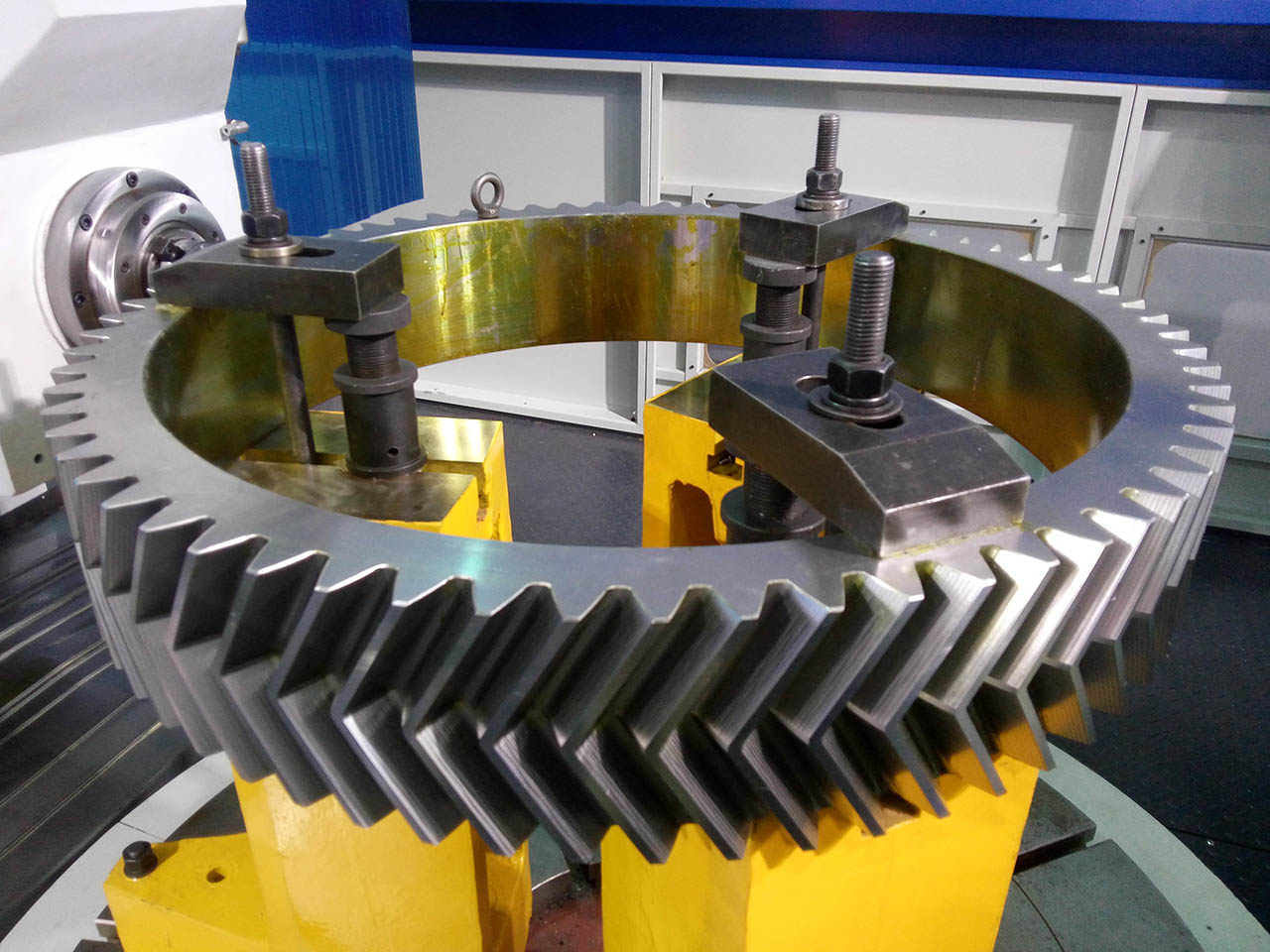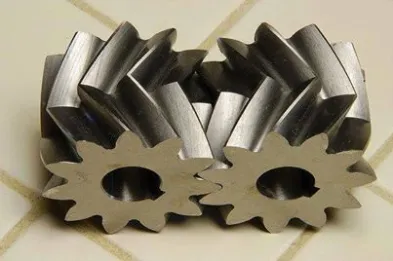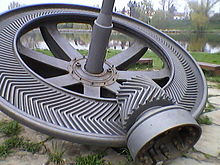Product Description
Product Description
A herringbone gear is a specific type of double helical gear. Each helical groove of this gear looks like the letter V, and many together form a herringbone pattern.
Kingrail Parts can produce all kinds of herringbone gear for mining machinery, mills, kilns and other equipment.
Specifications:
|
Material |
Carbon steel,Alloy steel |
||
|
Structure |
Forging,casting |
||
|
Type of gear |
Herringbone gear |
||
|
Heat treatment |
Quenching and tempering |
||
|
Process |
Forging, rough machining, QT, finish machining |
||
|
Main equipments |
Hobbing,CNC machine |
||
|
Module |
Up to 200 |
||
|
Precision of gear |
Grinding ISO Grade 5-7 & Hobbing ISO Grade 8-9 |
||
|
Inspection |
Raw material inspection, UT,physical property test,dimension inspect |
||
Kingrail Parts can customize herringbone gear according to customer’s specifications and requirements
Manufacturing process:
Rraw matrial — Forging testing– Turning — Drilling — Heat Treatment — Milling– Grinding — Shaping and hobbing Process — Packing — Shipping
After Sales Service
1. OEM and customized service.
2. Full machining, primer coating, surface treatment.
3. Complete material testing process.
4. Quality control
Contact us
If you have any questions, pls feel free to contact us
| Application: | Motor, Electric Cars, Motorcycle, Machinery, Marine, Toy, Agricultural Machinery, Car |
|---|---|
| Hardness: | Hardened Tooth Surface |
| Gear Position: | External Gear |
| Customization: |
Available
| Customized Request |
|---|
.shipping-cost-tm .tm-status-off{background: none;padding:0;color: #1470cc}
|
Shipping Cost:
Estimated freight per unit. |
about shipping cost and estimated delivery time. |
|---|
| Payment Method: |
|
|---|---|
|
Initial Payment Full Payment |
| Currency: | US$ |
|---|
| Return&refunds: | You can apply for a refund up to 30 days after receipt of the products. |
|---|

What are the benefits of using a herringbone gear mechanism?
Using a herringbone gear mechanism offers several benefits due to its unique design and characteristics. Here’s a detailed explanation of the advantages of using a herringbone gear mechanism:
- High Load Capacity: Herringbone gears are capable of handling high torque loads due to their double helical tooth design. The opposing helix angles of the two sides of the gear create a balanced load distribution, allowing for increased load-carrying capacity compared to other gear types. This makes herringbone gears suitable for applications that involve heavy loads and high power transmission requirements.
- Bidirectional Power Transmission: Herringbone gears are capable of transmitting power in both directions. The double helical tooth profile cancels out axial thrust forces that would occur in single helical gears, allowing for bidirectional power transfer without the need for additional thrust bearings or special mechanisms. This feature is particularly advantageous in applications where reversible power transmission is required.
- Smooth and Quiet Operation: The double helical tooth design of herringbone gears helps to cancel out axial and radial forces, resulting in smooth and quiet operation. The opposing helix angles of the two sides of the gear minimize gear vibrations and reduce noise levels during engagement. This makes herringbone gears suitable for applications where low noise and vibration are desired, such as precision machinery, printing presses, and automotive transmissions.
- Improved Gear Tooth Strength: The double helical tooth design of herringbone gears provides enhanced tooth strength compared to single helical gears. The opposing helix angles create a self-centering effect that reduces tooth deflection and improves load distribution along the tooth surfaces. This results in increased tooth strength, reduced wear, and improved overall gear durability, making herringbone gears suitable for high-load and high-speed applications.
- Efficient Torque Transfer: Herringbone gears offer efficient torque transfer due to their large contact area and overlapping tooth engagement. The double helical tooth profile provides a larger contact ratio compared to spur gears, resulting in improved power transmission efficiency and reduced stress concentrations on the gear teeth. This efficient torque transfer contributes to the overall performance and energy efficiency of the gear system.
- Axial Thrust Elimination: The double helical tooth profile of herringbone gears allows for the cancellation of axial thrust forces. The opposing helix angles create equal and opposite axial forces, effectively eliminating the net axial thrust on the gear shaft. This eliminates the need for additional thrust bearings or special provisions to counteract axial loads, simplifying the gear system design and reducing complexity and cost.
These are some of the key benefits of using a herringbone gear mechanism. Their high load capacity, bidirectional power transmission capability, smooth and quiet operation, improved tooth strength, efficient torque transfer, and axial thrust elimination make them advantageous in a wide range of applications across various industries.

How does a herringbone gear impact the overall efficiency of a system?
Herringbone gears can have a significant impact on the overall efficiency of a mechanical system. Their unique design and characteristics contribute to improved efficiency in several ways. Here’s a detailed explanation of how herringbone gears can influence the efficiency of a system:
- Reduced Friction: Herringbone gears are designed to minimize friction between the gear teeth during operation. The double helical arrangement of the teeth allows for opposing helix angles, which helps to cancel out the axial thrust generated by the gear meshing. This results in reduced sliding friction and less energy loss due to frictional forces, thereby improving overall efficiency.
- Smooth Operation: The herringbone gear design enables smooth and precise gear engagement. The opposing helix angles of the teeth facilitate the gradual meshing and unmeshing of the gears, reducing impact and shock loads. The smooth operation minimizes vibrations and noise levels, eliminating energy losses associated with excessive vibrations and improving the overall efficiency of the system.
- Higher Torque Capacity: Herringbone gears have a larger surface area of contact between the gear teeth compared to conventional spur gears. This increased contact area allows for higher torque transmission capabilities. By efficiently transmitting higher torque loads, herringbone gears help reduce the need for additional gear stages or larger gear sizes, resulting in a more compact and efficient system.
- Better Load Distribution: The double helical arrangement of the teeth in herringbone gears helps distribute the load more evenly across the gear face. This improved load distribution minimizes localized stress concentrations and wear on the gear teeth, leading to enhanced durability and reduced energy losses due to gear wear and failure.
- Efficient Power Transmission: Herringbone gears facilitate efficient power transmission by ensuring a high degree of gear meshing contact and proper alignment. The precise gear engagement reduces backlash and ensures optimal power transfer between the gears, resulting in higher transmission efficiency and minimal power losses within the system.
- Reduced Heat Generation: Herringbone gears’ smooth operation and reduced friction contribute to lower heat generation during gear meshing. The reduced heat generation helps to minimize thermal losses within the system. Additionally, the improved load distribution and larger contact area of herringbone gears help dissipate heat more effectively, further enhancing the overall efficiency of the system.
It’s important to note that the overall efficiency of a system is influenced by various factors, including gear design, lubrication, alignment, and the specific application and operating conditions. While herringbone gears offer several advantages that contribute to improved efficiency, it’s crucial to consider the entire system design and optimize other components and parameters accordingly to achieve the highest overall efficiency.

What are the applications of herringbone gears?
Herringbone gears, also known as double helical gears, find applications in various industries due to their unique design and advantages. Here’s a detailed explanation of the applications of herringbone gears:
- Power Transmission Systems: Herringbone gears are commonly used in power transmission systems that require efficient torque transfer and smooth operation. They are employed in gearboxes, drivetrains, and speed reducers where high torque and bidirectional power transmission are critical.
- Heavy Machinery: Herringbone gears are found in heavy machinery such as construction equipment, mining machinery, and industrial machinery. These gears can handle large loads and provide reliable torque transmission, making them suitable for applications that involve heavy-duty operations.
- Oil and Gas Industry: The oil and gas industry extensively uses herringbone gears in equipment like pumps, compressors, and turbines. These gears are capable of handling high torque requirements and provide reliable performance in demanding environments.
- Marine Propulsion Systems: Herringbone gears are utilized in marine propulsion systems, including ship propulsion drives and propeller shaft arrangements. Their ability to transmit high torque efficiently and smoothly makes them ideal for marine applications.
- High-Speed Gearboxes: Herringbone gears are employed in high-speed gearboxes where torque is transmitted at high rotational speeds. They are used in applications such as wind turbine gearboxes, aerospace systems, and high-performance automotive transmissions.
- Metalworking Machinery: Herringbone gears are utilized in metalworking machinery, such as milling machines, lathes, and gear cutting machines. These gears provide precise and reliable power transmission, enabling the machinery to perform various machining operations with accuracy.
- Railway Systems: Herringbone gears find applications in railway systems, particularly in locomotives and rolling stock. They facilitate efficient power transfer and contribute to smooth and reliable train operation.
- Printing Presses: Herringbone gears are used in printing presses to transmit power between different components of the press. Their ability to minimize vibrations and noise is advantageous in printing applications that require precision and high-quality printing results.
- Steel Mills: Herringbone gears are employed in steel mills for various applications, including rolling mills, heavy-duty cranes, and gear couplings. These gears withstand the demanding conditions of steel manufacturing, such as high loads, vibrations, and harsh environments.
These are just a few examples of the applications of herringbone gears. Their unique tooth design, load-carrying capacity, bidirectional power transmission capability, and smooth operation make them suitable for a wide range of industries and applications that require efficient and reliable torque transmission.


editor by CX 2023-12-13